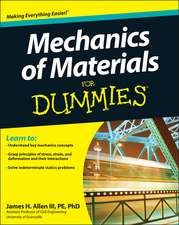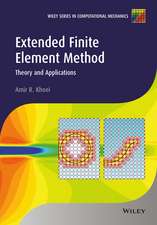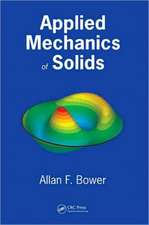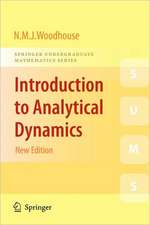Inverse Problems in Engineering Mechanics: IUTAM Symposium Tokyo, 1992: IUTAM Symposia
Editat de Masataka Tanaka, Huy D. Buien Limba Engleză Paperback – 31 iul 2012
Din seria IUTAM Symposia
- 15%
 Preț: 657.25 lei
Preț: 657.25 lei - 15%
 Preț: 642.51 lei
Preț: 642.51 lei - 15%
 Preț: 649.39 lei
Preț: 649.39 lei - 18%
 Preț: 965.20 lei
Preț: 965.20 lei - 15%
 Preț: 665.08 lei
Preț: 665.08 lei - 15%
 Preț: 647.08 lei
Preț: 647.08 lei - 15%
 Preț: 645.60 lei
Preț: 645.60 lei - 18%
 Preț: 962.35 lei
Preț: 962.35 lei - 15%
 Preț: 643.84 lei
Preț: 643.84 lei - 18%
 Preț: 959.98 lei
Preț: 959.98 lei - 15%
 Preț: 652.81 lei
Preț: 652.81 lei - 15%
 Preț: 653.46 lei
Preț: 653.46 lei - 15%
 Preț: 656.89 lei
Preț: 656.89 lei - 15%
 Preț: 648.42 lei
Preț: 648.42 lei - 18%
 Preț: 945.14 lei
Preț: 945.14 lei - 15%
 Preț: 653.14 lei
Preț: 653.14 lei - 15%
 Preț: 641.71 lei
Preț: 641.71 lei - 15%
 Preț: 649.71 lei
Preț: 649.71 lei - 15%
 Preț: 651.51 lei
Preț: 651.51 lei - 15%
 Preț: 662.30 lei
Preț: 662.30 lei - 15%
 Preț: 645.28 lei
Preț: 645.28 lei - 15%
 Preț: 646.11 lei
Preț: 646.11 lei - 18%
 Preț: 966.27 lei
Preț: 966.27 lei - 15%
 Preț: 648.89 lei
Preț: 648.89 lei - 15%
 Preț: 647.27 lei
Preț: 647.27 lei - 15%
 Preț: 650.86 lei
Preț: 650.86 lei - 15%
 Preț: 647.92 lei
Preț: 647.92 lei - 15%
 Preț: 655.45 lei
Preț: 655.45 lei - 15%
 Preț: 641.71 lei
Preț: 641.71 lei - 15%
 Preț: 650.04 lei
Preț: 650.04 lei - 15%
 Preț: 654.30 lei
Preț: 654.30 lei - 15%
 Preț: 649.54 lei
Preț: 649.54 lei - 15%
 Preț: 648.05 lei
Preț: 648.05 lei - 15%
 Preț: 644.82 lei
Preț: 644.82 lei - 15%
 Preț: 638.43 lei
Preț: 638.43 lei - 15%
 Preț: 648.24 lei
Preț: 648.24 lei - 15%
 Preț: 646.75 lei
Preț: 646.75 lei - 15%
 Preț: 647.59 lei
Preț: 647.59 lei - 15%
 Preț: 648.24 lei
Preț: 648.24 lei - 15%
 Preț: 646.11 lei
Preț: 646.11 lei - 15%
 Preț: 654.77 lei
Preț: 654.77 lei - 15%
 Preț: 664.77 lei
Preț: 664.77 lei - 15%
 Preț: 639.08 lei
Preț: 639.08 lei - 15%
 Preț: 662.80 lei
Preț: 662.80 lei - 15%
 Preț: 648.05 lei
Preț: 648.05 lei - 18%
 Preț: 1836.01 lei
Preț: 1836.01 lei - 15%
 Preț: 657.73 lei
Preț: 657.73 lei - 15%
 Preț: 640.71 lei
Preț: 640.71 lei - 15%
 Preț: 653.79 lei
Preț: 653.79 lei - 15%
 Preț: 651.67 lei
Preț: 651.67 lei
Preț: 404.67 lei
Nou
Puncte Express: 607
Preț estimativ în valută:
77.43€ • 81.05$ • 64.45£
77.43€ • 81.05$ • 64.45£
Carte tipărită la comandă
Livrare economică 31 martie-14 aprilie
Preluare comenzi: 021 569.72.76
Specificații
ISBN-13: 9783642524417
ISBN-10: 3642524419
Pagini: 584
Ilustrații: XV, 564 p.
Dimensiuni: 155 x 235 x 31 mm
Greutate: 0.81 kg
Ediția:Softcover reprint of the original 1st ed. 1993
Editura: Springer Berlin, Heidelberg
Colecția Springer
Seria IUTAM Symposia
Locul publicării:Berlin, Heidelberg, Germany
ISBN-10: 3642524419
Pagini: 584
Ilustrații: XV, 564 p.
Dimensiuni: 155 x 235 x 31 mm
Greutate: 0.81 kg
Ediția:Softcover reprint of the original 1st ed. 1993
Editura: Springer Berlin, Heidelberg
Colecția Springer
Seria IUTAM Symposia
Locul publicării:Berlin, Heidelberg, Germany
Public țintă
ResearchCuprins
List of Contents.- 1 Mathematical Aspects.- On Regularization Methods within System Identification.- New Approaches to the Optimal Regularization.- A Method for Solving Inverse Boundary-Value Problems Using Symbolic Computation.- An Application of the Fuzzy Control for an Ill-posed Problem.- Inverse Filtering for Reverberant Transfer Functions.- 2 Computational Aspects.- Classification of Inverse Problems Arising in Field Problems and Their Treatments.- A Physically Based Method of Experimental Data-Concepts, Formulation and Application to Identification of Residual Stresses.- Inverse Problems for Vibrating Systems in Two and Three Dimensions.- Inverse Spectrum Problems for Block Jacobi Matrix.- Parametric Correction of Finite Element Models Using Modal Tests.- Structural Defect Synthesis Using Noise-Frequency Response Characteristics for Coupled Acoustic-Structural System by Fuzzy Inference Method.- Inverse Problem Solution in Non-destructive Pavement Diagnostics -Computational Aspects.- Inverse Formulation for Incompressible Viscous Two-Dimensional and Axisymmetric Flow Problems.- 3 Parameter Identification.- Requirements for the Structure of Analytical Models Used for Parameter Identification.- Inverse Problem in Mechanics of Structures: a New Approach Based on Displacement Field Processing.- New Method for Determining Contact Pressure Disributions by Using Caustic Images.- Estimation of Impact Force by an Inverse Analysis.- Optimality of Internal Structure and Identification of Unknown Load.- 4 Shape Determination and Optimization.- Shape Identification Using Acoustic Measurements: A Numerical Investigation Using BIE and Shape Differentiation.- Shape Determination of a Scattering Obstacles by Eigenfunction Expansion Embedding Integral Method.- Indentification of Crack Shape Hidden in Solid by Means of Neural Network and Computational Mechanics.- Approximate Recovery and Redesign of a Curved Surface Based on a Flattened Form.- Optimum Design of a Sound-Insulating Wall by the Boundary Element Method.- Optimal Design of Cooling Lines of Injection Mold Based on Boundary Element Design Sensitivity Analysis.- Efficient Shape Optimization Technique Based on Boundary Element Method.- 5 Material Property Characterization.- Inversion of Surface Acoustic Wave Data to Determine the Elastic Constants of Nitride Films.- Inversion of Source, Material, and Defect Characteristics Using Guided Waves.- Inverse Problems Associated with Nondestructive Evaluation of Plasic Damages in Solids.- Identification Aspects of Inhomogeneous Materials.- A Parameter Identification Procedure as a Dual Boundary Control Concept for Wave-Propagation Problem.- Identification of Dynamic in Situ Soil Properties at Existing Structure Site.- Characterization of the Damping Effect of a Vibrating System.- Identification of Parameters in Geomechanics Using a Maximum Likelihood Approach.- Identification Analysis of Distributed-Parameter Systems by Using Kalman Filter-Boundary Element Method.- 6 Elastodynamic Inverse Problems.- Inverse Scattering for Flaw Type Classification.- Shape Inversion from Phase Shifts.- Determination of Shapes, Sizes and Material Compositions of Large Inclusions in Elastic Media from Scattered Waves.- Estimation of Unknown Boundary Values by Inverse Analysis with Elastodynamic Boundary Element Method.- Source Inversion of High-Frequency Strong Motion Records in the Near-Source Region.- Optimum Strong-Motion Station-Array Geometry for Earthquake Source Studies.- 7 Ultrasonic Nondestructive Evaluation.- Neural Network Approach to the Inverse Problem ofCrack- Depth Determination from Ultrasonic Backscattering Data.- Simulation of Directivity Synthesis for Ultrasonic Transducers.- Inversion Using Multi-Tip Echoes of Elastic Waves.- Surface Reconstruction of a Three-Dimensional Ultrasonic Flaw.- Generalized Ray Theory and Its Application to Long-Distance Ultrasonic Testing.- A New Approach to Ultrasonic Image Reconstruction.- 8 Thermal Inverse Problems.- Identification of Heat Conduction Coefficient: Application to Nondestructive Testing.- Determination of Void Shapes, Sizes, Numbers and Locations Inside an Object with Known Surface Temperatures and Heat Fluxes.- Determination of Time Dependence of Temperature in the Inner Surface of a Cylinder by Measured Informations on the Outer Surface.- Transfer Function Approach for Solving Inverse Heat Conduction Problems in Piping Using Experimental Data.- A Method for Disbond Detection in Thermal Tomography by Domain Decomposition Method.- 9 Other Engineering Applications.- Inverse Problem Approach Based on the Kalman Filtering and Its Applications.- The Thin Shell Approach for Some 3D Engineering Inverse Problems.- Inverse Analysis for Estimating Galvanic Corrosion Rate.- Estimation of an Electric Orbit Using Super-Potentials of Lienard-Wiechert Potentials.









